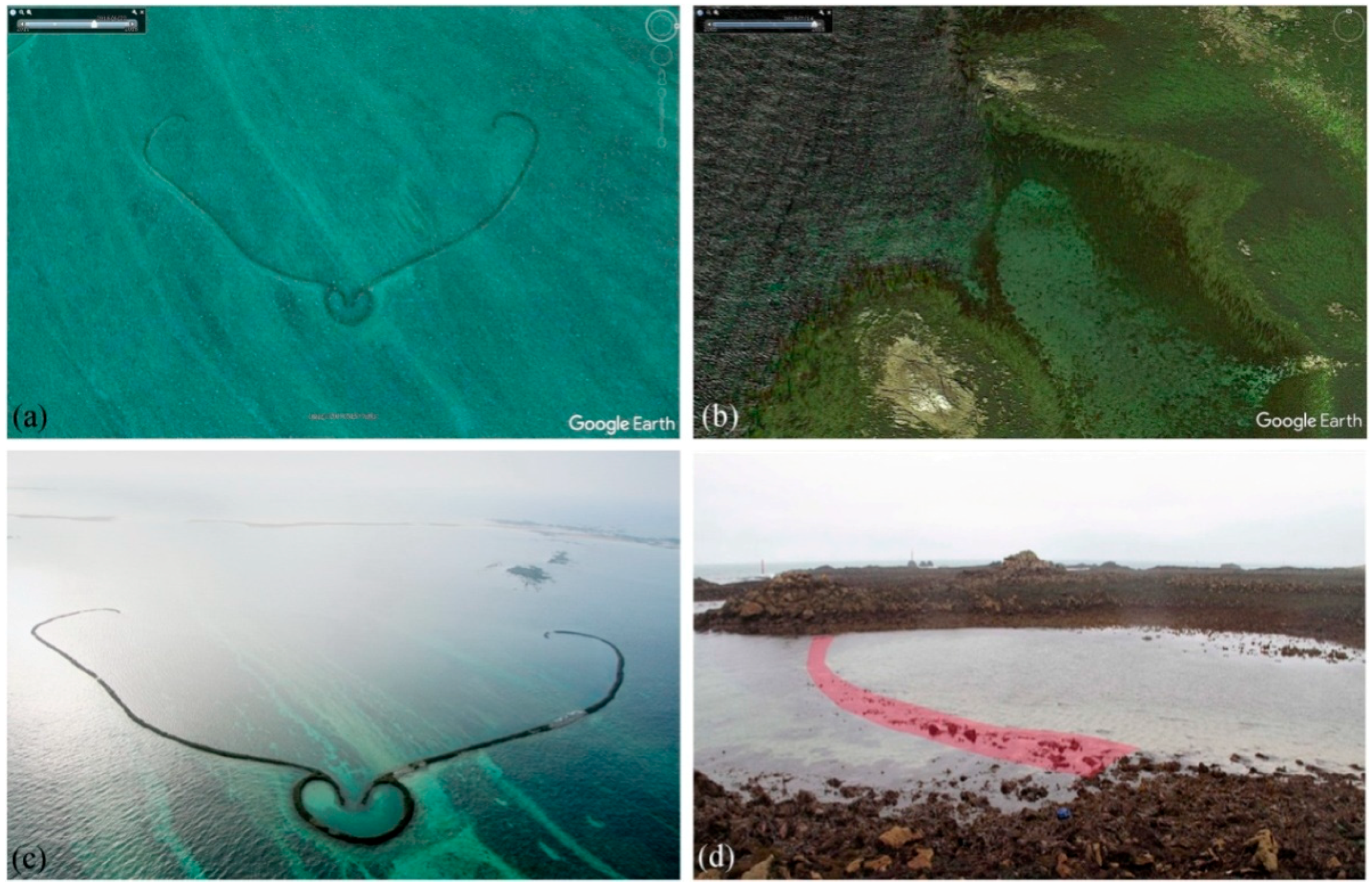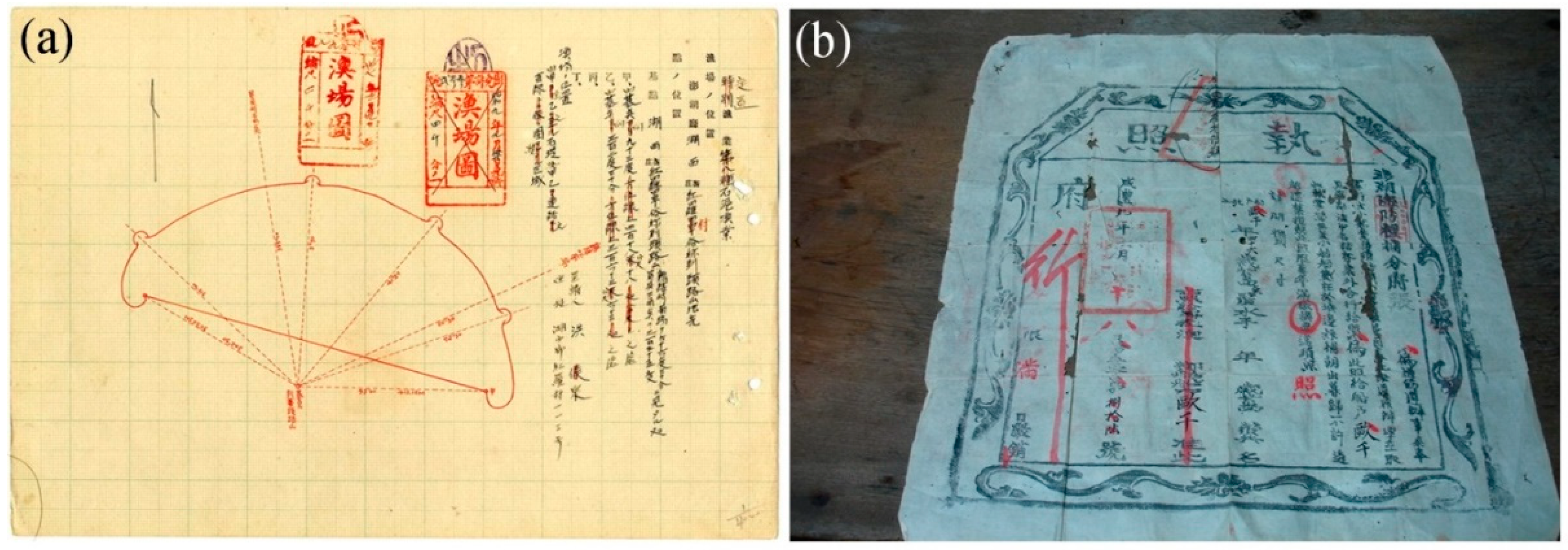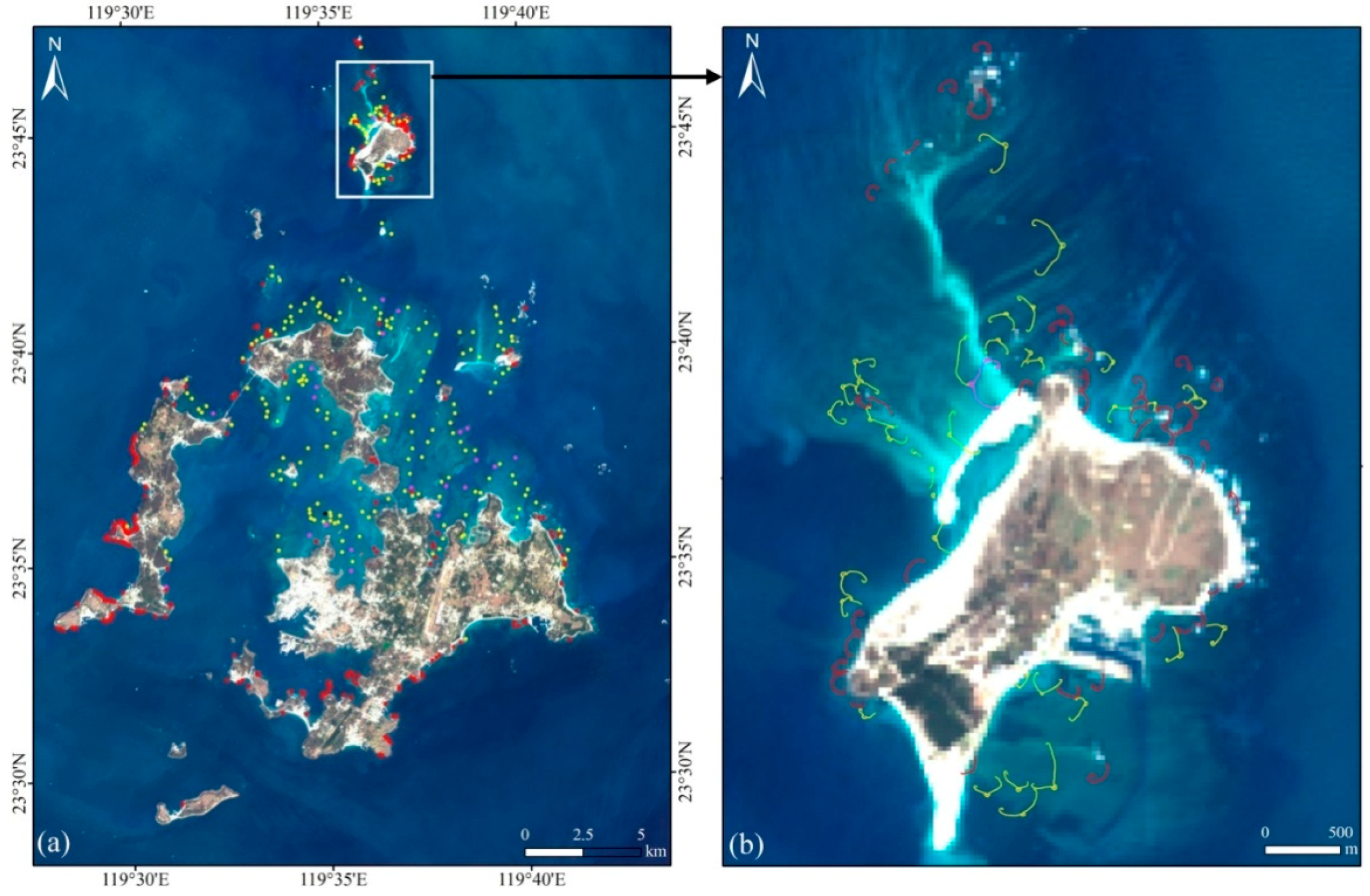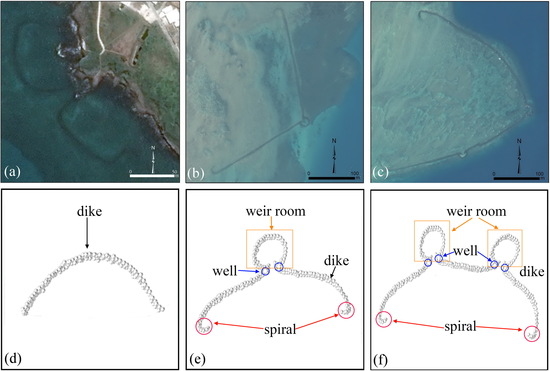Low-Cost Archaeological Investigation and Rapid Mapping of Ancient Stone Tidal Weirs in the Penghu Archipelago Using Google Earth
Abstract
:1. Introduction
2. STWs in Penghu
2.1. Study Area and Regional Settings
2.2. Cultural and Archaeological Contexts
2.3. Morphological Features
3. Investigation Methods
4. Results and Discussion
4.1. STWs on Penghu Island
4.2. Validations
4.3. Spatial Distribution Patterns
4.4. Sustainability
4.5. Limitations of GE
5. Conclusions
Author Contributions
Funding
Acknowledgments
Conflicts of Interest
References
- Corte, G.; Yokoyama, L.; Amaral, A. An attempt to extend the Habitat Harshness Hypothesis to tidal flats: A case study of Anomalocardiabrasiliana (Bivalvia: Veneridae) reproductive biology. Estuar. Coast. Shelf Sci. 2014, 150, 136–141. [Google Scholar] [CrossRef]
- Ting, L. Stone Weirs on Chipei Island, Taiwan: Landesque Capital and Ecologically Unequal Exchange. Master’s Thesis, Lund University, Lund, Sweden, June 2009. [Google Scholar]
- Fitzpatrick, S.; Rick, T.; Erlandson, J. Recent progress, trends, and developments in island and coastal archaeology. J. Isl. Coast. Archaeol. 2015, 10, 3–27. [Google Scholar] [CrossRef]
- Pichler, H.; Spach, H.; Gray, C.; Broadhurst, M.; Junior, R.; Neto, J. Environmental influences on resident and transient fishes across shallow estuarine beaches and tidal flats in a Brazilian World Heritage area. Estuar. Coast. Shelf Sci. 2015, 164, 482–492. [Google Scholar] [CrossRef]
- Howard, P.; Pinder, D. Cultural heritage and sustainability in the coastal zone: Experiences in southwest. Eng. J. Cult. Herit. 2003, 4, 57–68. [Google Scholar] [CrossRef]
- Madariaga, C.; Hoyo, J. Enhancing of the cultural fishing heritage and the development of tourism: A case study in Isla Cristina (Spain). Ocean Coast. Manag. 2019, 168, 1–11. [Google Scholar] [CrossRef]
- Wikipedia. Available online: https://en.wikipedia.org/wiki/Fishing_weir (accessed on 3 May 2018).
- Nishimura, A. Legal conditions of Ishihibi, living fossil of the oldest fishing gear. Co. Law Rev. 1969, 5, 73–116. (In Japanese) [Google Scholar]
- Chen, X. Investigation into the stone tidal weirs in the Penghu Islands. Geogr. Res. 1996, 25, 117–140. (In Chinese) [Google Scholar]
- Mcniven, I.; Crouch, J.; Richards, T.; Sniderman, K.; Dolby, N.; Mirring, G. Phased redevelopment of an ancient gunditjmara fish trap over the past 800 years: Muldoons trap complex, lake condah, southwestern victoria. Austr. Archaeol. 2015, 81, 44–58. [Google Scholar] [CrossRef]
- Erlandson, J.M. The archaeology of aquatic adaptations: Paradigms for a new millennium. J. Archaeol. Res. 2001, 9, 287–350. [Google Scholar] [CrossRef]
- Erlandson, J.M.; Graham, M.H.; Bourque, B.J.; Corbett, D.; Estes, J.A.; Steneck, R.S. The kelp highway hypothesis: Marine ecology, the coastal migration theory, and the peopling of the Americas. J. Isl. Coast. Archaeol. 2007, 2, 161–174. [Google Scholar] [CrossRef]
- Fitzpatrick, S.M.; Thompson, V.D.; Poteate, A.S.; Napolitano, M.F.; Erlandson, J.M. Marginalization of the margins: The importance of smaller islands in human prehistory. J. Isl. Coast. Archaeol. 2016, 11, 155–170. [Google Scholar] [CrossRef]
- Elder, J.T.; Gilmour, D.M.; Butler, V.L.; Campbell, S.K.; Steingraber, A. On the role of coastal landscape evolution in detecting fish weirs: A Pacific Northwest Coast example from Washington State. J. Isl. Coast. Archaeol. 2014, 9, 45–71. [Google Scholar] [CrossRef]
- Hritz, C. A malarial-ridden swamp: Using Google Earth Pro and Corona to access the southern Balikh valley, Syria. J. Archaeol. Sci. 2013, 40, 1975–1987. [Google Scholar] [CrossRef]
- Langouët, L.; Daire, M. Ancient maritime fish-traps of Brittany (France): A reappraisal of the relationship between human and coastal environment during the Holocene. J. Marit. Archaeol. 2009, 4, 131–148. [Google Scholar] [CrossRef]
- Nishimura, A. Living stone tidal weirs of East Asia in transition fossils of fixed fishing gear: Investigation into the relics of stone tidal weirs constructed along the coast of the Miyako Archipelago in Okinawa. Jpn. J. Ethnology 1979, 44, 223–259. (In Japanese) [Google Scholar]
- Gandois, H.; Stéphan, P.; Cuisnier, D.; Hulot, O.; Ehrhold, A.; Paul, M.; Dantec, N.; Franzetti, M. The stone tidal fish weirs of the Molène Archipelago, Iroise Sea, Brittany, Western France: A long-term tradition with early megalithic origins. Int. J. Nautical Archaeol. 2018, 47, 5–27. [Google Scholar] [CrossRef]
- Tawa, M. Stone Tidal Weirs of East Asia in Transition. Humanit. Rev. 2010, 59, 95–107. [Google Scholar]
- Jeffery, B. Reviving community spirit: Furthering the sustainable, historical and economic role of fish weirs and traps. J. Mari. Arch. 2013, 8, 29–57. [Google Scholar] [CrossRef]
- Stone Tidal Weirs, Underwater Cultural Heritage or Not? Available online: http://www.themua.org/collections/items/show/1623 (accessed on 27 May 2018).
- Luo, L.; Wang, X.; Guo, H.; Lasaponara, R.; Zong, X.; Masini, N.; Wang, G.; Shi, P.; Khatteli, H.; Chen, F.; et al. Airborne and spaceborne remote sensing for archaeological and cultural heritage applications: A review of the century (1907–2017). Remote Sens. Environ. 2019, 232. [Google Scholar] [CrossRef]
- Luo, L.; Wang, X.; Liu, J.; Guo, H. Ancient stone tidal weirs in Penghu archipelago: Distribution, category, structure and function, a Google Earth and GIS approach. ISPRS Int. Arch. Photogramm. Remote Sens. Spat. Inf. Sci. 2015, XL-5/W7, 311–314. [Google Scholar] [CrossRef]
- Lasaponara, R.; Masini, N. Space-Based Identification of Archaeological Illegal Excavations and a New Automatic Method for Looting Feature Extraction in Desert Areas. Surv. Geophys. 2018, 39, 1323–1346. [Google Scholar] [CrossRef]
- Cuca, B.; Hadjimitsis, D. Space technology meets policy: An overview of Earth Observation sensors for monitoring of cultural landscapes within policy framework for Cultural Heritage. J. Archaeol. Sci. Rep. 2017, 14, 727–733. [Google Scholar] [CrossRef] [Green Version]
- Stott, D.; Kristiansena, S.; Lichtenberger, A.; Rajac, R. Mapping an ancient city with a century of remotely sensed data. Proc. Natl. Acad. Sci. USA 2018, 115, E5450–E5458. [Google Scholar] [CrossRef] [PubMed] [Green Version]
- Xiao, W.; Mills, J.; Guidi, G.; Rodríguez-Gonzálvez, P.; Gonizzi Barsanti, S.; González-Aguilera, D. Geoinformatics for the conservation and promotion of cultural heritage in support of the UN Sustainable Development Goals. ISPRS J. Photogramm. Remote Sens. 2018, 142, 389–406. [Google Scholar] [CrossRef]
- Lasaponara, R.; Masini, N. Satellite Remote Sensing: A New Tool for Archaeology; Springer: Berlin, Germany, 2012; pp. 3–16. [Google Scholar]
- Luo, L.; Wang, X.; Liu, C.; Guo, H.; Du, X. Integrated RS, GIS and GPS approaches to archaeological prospecting in the Hexi Corridor, NW China: A case study of the royal road to ancient Dunhuang. J. Archaeol. Sci. 2014, 50, 178–190. [Google Scholar] [CrossRef]
- Agapiou, A.; Alexakis, D.; Hadjimitsis, D. Spectral sensitivity of ALOS, ASTER, IKONOS, LANDSAT and SPOT satellite imagery intended for the detection of archaeological crop marks. Int. J. Digit. Earth 2014, 7, 351–372. [Google Scholar] [CrossRef]
- Palmer, R. Google Maps. AARGnews 2005, 31, 38–39. [Google Scholar]
- Ur, J. Google Earth and archaeology. SAA Archaeol. Rec. 2006, 6, 35–38. [Google Scholar]
- Myers, A. Camp Delta, Google Earth and the ethics of remote sensing in archaeology. World Archaeol. 2010, 42, 455–467. [Google Scholar] [CrossRef]
- Luo, L.; Wang, X.; Guo, H.; Liu, C.; Liu, J.; Li, L.; Du, X.; Qian, G. Automated extraction of the archaeological tops of Qanat Shafts from VHR imagery in Google Earth. Remote Sens. 2014, 6, 11956–11976. [Google Scholar] [CrossRef]
- Luo, L.; Wang, X.; Guo, H.; Lasaponara, R.; Shi, P.; Bachagha, N.; Li, L.; Yao, Y.; Masini, N.; Chen, F. Google Earth as a Powerful Tool for Archaeological and Cultural Heritage Applications: A Review. Remote Sens. 2018, 10, 1558. [Google Scholar] [CrossRef]
- Yu, L.; Gong, P. Google Earth as a virtual globe tool for Earth science applications at the global scale: Progress and perspectives. Int. J. Remote Sens. 2012, 33, 3966–3986. [Google Scholar] [CrossRef]
- Chang, A.; Parrales, M.; Jimenez, J.; Sobieszczyk, M.; Hammer, S.; Copenhaver, D.; Kulkarni, R. Combining Google Earth and GIS mapping technologies in a dengue surveillance system for developing countries. Int. J. Health Geogr. 2009, 8, 1–11. [Google Scholar] [CrossRef] [PubMed]
- Parks, L. Digging into Google Earth: An analysis of “Crisis in Darfur”. Geoforum 2009, 40, 535–545. [Google Scholar] [CrossRef]
- Trujillo, P.; Piroddi, C.; Jacquet, J. Fish Farms at Sea: The Ground Truth from Google Earth. PLoS ONE 2012, 7, e30546. [Google Scholar] [CrossRef] [PubMed]
- Goudie, A. Characterising the distribution and morphology of creeks and pans on salt marshes in England and Wales using Google Earth. Estuar. Coast. Shelf Sci. 2013, 129, 112–123. [Google Scholar] [CrossRef]
- Yang, X.; Jiang, G.; Luo, X.; Zheng, Z. Preliminary mapping of high-resolution rural population distribution based on imagery from Google Earth: A case study in the Lake Tai basin, eastern China. Appl. Geogr. 2012, 32, 221–227. [Google Scholar] [CrossRef]
- Beck, A. Google earth and world wind: Remote sensing for the masses? Antiquity 2006, 80, 308. [Google Scholar]
- Ur, J. CORONA satellite photography and ancient road networks: A northern Mesopotamian case study. Antiquity 2003, 77, 102–115. [Google Scholar] [CrossRef]
- Thomas, D.; Kidd, F.; Nikolovski, S.; Zipfel, C. The archaeological sites of Afghanistan in Google Earth. AARGnews 2008, 37, 22–30. [Google Scholar]
- Myers, A. Field work in the age of digital reproduction: A review of the potentials and limitations of Google Earth for archaeologists. SAA Archaeol. Rec. 2010, 4, 7–11. [Google Scholar]
- Pringle, H. Google Earth shows clandestine worlds. Science 2010, 329, 1008–1009. [Google Scholar] [CrossRef] [PubMed]
- Kaimaris, D.; Georgoula, O.; Patias, P.; Stylianidis, E. Comparative analysis on the archaeological content of imagery from Google Earth. J. Cult. Herit. 2011, 12, 263–269. [Google Scholar] [CrossRef]
- Kennedy, D.; Bishop, M. Google earth and the archaeology of Saudi Arabia: A case study from the Jeddah area. J. Archaeol. Sci. 2011, 38, 1284–1293. [Google Scholar] [CrossRef]
- Sadr, K.; Rodier, X. Google Earth, GIS and stone-walled structures in southern Gauteng, South Africa. J. Archaeol. Sci. 2012, 39, 1034–1042. [Google Scholar] [CrossRef]
- Fish Weir—Ancient Fishing Tool of Hunter-Gatherers, an 8000 Year Old Fishing Technology. Available online: https://www.thoughtco.com/fish-weir-ancient-fishing-tool-170925 (accessed on 27 March 2018).
- Kempe, S.; Al-Malabeh, A. Desert kites in Jordan and Saudi Arabia: Structure, statistics and function, a Google Earth study. Quatern. Int. 2013, 297, 126–146. [Google Scholar] [CrossRef]
- Parcak, S.; Gathings, D.; Childs, C.; Mumford, G.; Cline, E. Satellite evidence of archaeological site looting in Egypt: 2002–2013. Antiquity 2016, 90, 188–205. [Google Scholar] [CrossRef]
- Magli, G. The sacred landscape of the “Pyramids” of the Han Emperors: A cognitive approach to sustainability. Sustainability 2019, 11, 789. [Google Scholar] [CrossRef]
- Hong, G. Stone Tidal Weirs in Penghu Islands; Penghu Cultural Affairs Bureau: Penghu, China, 1999; pp. 48–218. (In Chinese) [Google Scholar]
- Li, M. Origin and Distribution of Fish. Weir Culture, an Exploration with an International Perspective; Penghu Cultural Affairs Bureau: Penghu, China, 2009; pp. 52–64. (In Chinese) [Google Scholar]
- Li, M. Stone Weirs of Penghu Islands. China Scenic 2014, 5, 109–118. [Google Scholar]
- Li, M.; Zhan, Y. Digital archives program of Penghu stone tidal weirs. Coral Stone 2006, 44, 2–19. (In Chinese) [Google Scholar]






| Categories | Size in Length (m) | ||||
|---|---|---|---|---|---|
| (0, 100) | (100, 300) | (300, 500) | (500, 1000) | >1000 | |
| Arched | 74 | 188 | 17 | 0 | 0 |
| Single | 7 | 49 | 81 | 89 | 10 |
| Double | 0 | 2 | 4 | 14 | 4 |
| Total | 81 | 239 | 102 | 103 | 14 |
| Types | 2015 Inventory | 2018 Inventory | ||||
|---|---|---|---|---|---|---|
| GE (G) | Reference (R) | G/R×100% | GE (G) | Reference (R) | G/R×100% | |
| Arched | 252 | 311 | 81.03 | 279 | 311 | 89.71 |
| Single | 227 | 254 | 89.37 | 236 | 254 | 92.91 |
| Double | 24 | 27 | 88.89 | 24 | 27 | 88.89 |
| Total | 503 | 592 | 84.97 | 539 | 592 | 91.04 |
© 2019 by the authors. Licensee MDPI, Basel, Switzerland. This article is an open access article distributed under the terms and conditions of the Creative Commons Attribution (CC BY) license (http://creativecommons.org/licenses/by/4.0/).
Share and Cite
Luo, L.; Wang, X.; Liu, J.; Zheng, W.; Zhen, J.; Zhu, L.; Liu, C.; Wan, H. Low-Cost Archaeological Investigation and Rapid Mapping of Ancient Stone Tidal Weirs in the Penghu Archipelago Using Google Earth. Sustainability 2019, 11, 4536. https://0-doi-org.brum.beds.ac.uk/10.3390/su11174536
Luo L, Wang X, Liu J, Zheng W, Zhen J, Zhu L, Liu C, Wan H. Low-Cost Archaeological Investigation and Rapid Mapping of Ancient Stone Tidal Weirs in the Penghu Archipelago Using Google Earth. Sustainability. 2019; 11(17):4536. https://0-doi-org.brum.beds.ac.uk/10.3390/su11174536
Chicago/Turabian StyleLuo, Lei, Xinyuan Wang, Jie Liu, Wenwu Zheng, Jing Zhen, Lanwei Zhu, Chuansheng Liu, and Hong Wan. 2019. "Low-Cost Archaeological Investigation and Rapid Mapping of Ancient Stone Tidal Weirs in the Penghu Archipelago Using Google Earth" Sustainability 11, no. 17: 4536. https://0-doi-org.brum.beds.ac.uk/10.3390/su11174536






